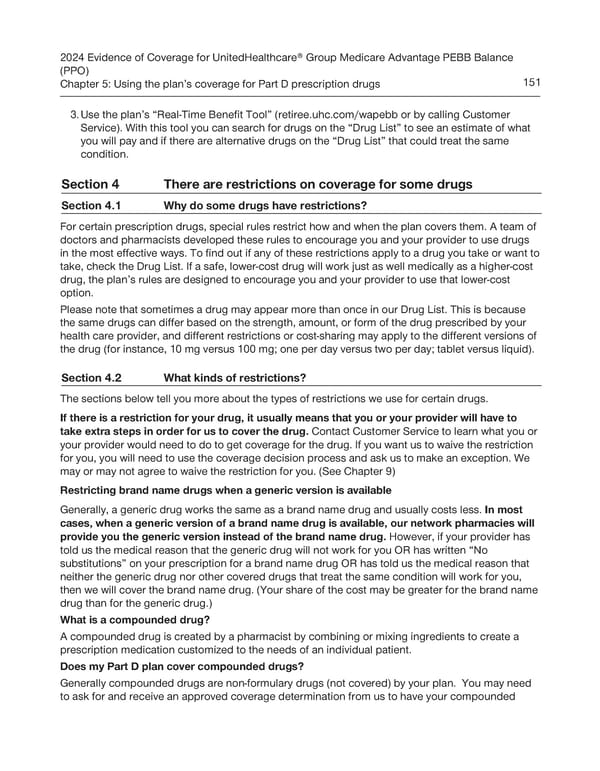2024 Evidence of Coverage for UnitedHealthcare® Group Medicare Advantage PEBB Balance (PPO) Chapter 5: Using the plan’s coverage for Part D prescription drugs 151 3. Use the plan’s “Real-Time Benefit Tool” (retiree.uhc.com/wapebb or by calling Customer Service). With this tool you can search for drugs on the “Drug List” to see an estimate of what you will pay and if there are alternative drugs on the “Drug List” that could treat the same condition. Section 4 There are restrictions on coverage for some drugs Section 4.1 Why do some drugs have restrictions? For certain prescription drugs, special rules restrict how and when the plan covers them. A team of doctors and pharmacists developed these rules to encourage you and your provider to use drugs in the most effective ways. To find out if any of these restrictions apply to a drug you take or want to take, check the Drug List. If a safe, lower-cost drug will work just as well medically as a higher-cost drug, the plan’s rules are designed to encourage you and your provider to use that lower-cost option. Please note that sometimes a drug may appear more than once in our Drug List. This is because the same drugs can differ based on the strength, amount, or form of the drug prescribed by your health care provider, and different restrictions or cost-sharing may apply to the different versions of the drug (for instance, 10 mg versus 100 mg; one per day versus two per day; tablet versus liquid). Section 4.2 What kinds of restrictions? The sections below tell you more about the types of restrictions we use for certain drugs. If there is a restriction for your drug, it usually means that you or your provider will have to take extra steps in order for us to cover the drug. Contact Customer Service to learn what you or your provider would need to do to get coverage for the drug. If you want us to waive the restriction for you, you will need to use the coverage decision process and ask us to make an exception. We may or may not agree to waive the restriction for you. (See Chapter 9) Restricting brand name drugs when a generic version is available Generally, a generic drug works the same as a brand name drug and usually costs less. In most cases, when a generic version of a brand name drug is available, our network pharmacies will provide you the generic version instead of the brand name drug. However, if your provider has told us the medical reason that the generic drug will not work for you OR has written “No substitutions” on your prescription for a brand name drug OR has told us the medical reason that neither the generic drug nor other covered drugs that treat the same condition will work for you, then we will cover the brand name drug. (Your share of the cost may be greater for the brand name drug than for the generic drug.) What is a compounded drug? A compounded drug is created by a pharmacist by combining or mixing ingredients to create a prescription medication customized to the needs of an individual patient. Does my Part D plan cover compounded drugs? Generally compounded drugs are non-formulary drugs (not covered) by your plan. You may need to ask for and receive an approved coverage determination from us to have your compounded
 UnitedHealthcare PEBB Balance EOC (2024) Page 156 Page 158
UnitedHealthcare PEBB Balance EOC (2024) Page 156 Page 158